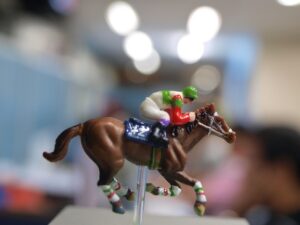Grand National 2025 Preview – Contenders
 The 2025 Grand National is scheduled for 16:00 on April 5, but entries for the world-famous steeplechase closed on January 28 and the weights were published on February 11, allowing the ante-post market to take shape. At the time of writing, after the first scratching deadline on February 25, 81 horses stood their ground in the National which, nowadays, has a safety limit of 34. A further scratching deadline follows on February 25, with five-day declarations on March 31 and 48-hour declarations on April 3, before the final field is revealed. At that stage, all bar the top 34 in the weights will be ballotted out, leaving the remainder to compete for £1 million in prize money, half of which goes to winning connections.
The 2025 Grand National is scheduled for 16:00 on April 5, but entries for the world-famous steeplechase closed on January 28 and the weights were published on February 11, allowing the ante-post market to take shape. At the time of writing, after the first scratching deadline on February 25, 81 horses stood their ground in the National which, nowadays, has a safety limit of 34. A further scratching deadline follows on February 25, with five-day declarations on March 31 and 48-hour declarations on April 3, before the final field is revealed. At that stage, all bar the top 34 in the weights will be ballotted out, leaving the remainder to compete for £1 million in prize money, half of which goes to winning connections.
At the time of writing, the weights are headed by the 2024 winner, I Am Maximus (14/1), trained by Willie Mullins, who has since been plying his trade, without much distinction in Grade 1 company. The Authorized gelding was pulled up, when tailed off, behind stable companion Galopin Des Champs in the Savills Chase at Leopardstown over Christmas on his seasonal debut, but fared a little better when a keeping on eighth, beaten 17 lengths, behind the same horse in the Irish Gold Cup, over the same course and distance, in early February. That latter piece of form leaves him nearly 10 lengths to find with ante-post favourite Inothewayurthinkin (8/1), who is also owned J.P. McManus, with whom he is 7lb worse off at Aintree. I Am Maximus is 8lb higher in the weights this year than last, but back at Aintree could well leave his previous form this season well behind.
Of course, with a focus on Grand National Runners , I Am Maximus potentially faces a whole raft of formidable rivals, some of who are also trained by Willie Mullins and/or owned by J.P. McManus. Nick Rockett (14/1), for example, is a stable companion at Muine Bheag, Co. Carlow and boasts solid credentials, not least because he has won the Grade 3 Bobbyjo Chase at Fairyhouse since the National weights were published. On that occasion, he edged out Intense Raffles (10/1), who could re-oppose on 15lb better terms, for just three-quarters of a length, at Aintree and appears remarkably well handicapped on that evidence. Nevertheless, Nick Rockett remains a progressive, stoutly-bred eight-year-old, who ran creditably on his only previous visit to Britain, in the Bet365 Gold Cup at Sandown last spring, and is definitely one to consider.
Strictly speaking, Nick Rockett also has his work cut out to reverse earlier form with Perceval Legallois (20/1), who beat him by just over nine lengths in the Paddy Power Chase at Leopardstown over Christmas and is 11lb better off in the National. Owned by McManus and trained by Gavin Cromwell in Navan, Co. Meath, Perceval Legallois is a stable companion of Inothewayurthinkin, but is clearly no slouch, having taking advantage of a lower hurdles mark to win a valuable race in that sphere at Leopardstown on his most recent outing in early February. He has yet to win beyond an extended three miles, but acts on any going and still looks reasonably handicapped on what he has achieved so far.
Gavin Cromwell could also saddle Stumptown (20/1), who is an intresting contender insofar as he is, at the time of writing, 3-4 in cross country chases and ante-post favourite for the Glenfarclas Cross Country Chase at the Cheltenham Festival. He is lumbered with top weight of 11st 10lb at Prestbury Park but, as the weights stand, set to carry 8lb less at Aintree. He could seek to emulate Tiger Roll, who won the Glenfarclas Cross Country Chase (albeit when it was still a conditions race, rather than a handicap) en route to Grand National glory in both 2018 and 2019.
Iroko (14/1), trained by Oliver Greenall and Josh Guerriero in Oldcastle Heath, Cheshire, but yet another owned by that man McManus, is currently the shortest-priced of the home contigent. The winner of the Martin Pipe Conditional Jockeys’ Handicap Hurdle at the 2023 Cheltenham Festival, he has not won since November that year and is currently just 1-7 over fences, for all that he has been highly tried more than once in his steeplechasing career. Indeed, he is well handicapped with Inothewayurthinkin on their running in the Mildmay Novices’ Chase at Aintree last April. A first fence fall, albeit after being hampered by a rival, in a graduation chase at Ascot tempers enthusiasm for his chances of completing the National Course without mishap, but his subsequent, tenderly-handled fourth at Newbury (which was subject to a stewards’ enquiry) suggests there is some mileage in his current handicap mark if he does.
Now 14-time champion trainer Paul Nicholls knows what it takes to win the Grand National, having done so, narrowly, with Neptune Collonges in 2012. The Master of Manor Farm has a handful of entries in 2025, the pick of which, according to the bookmakers, could be Kandoo Kid (25/1). The nine-year-old son of useful jumps sire Kapgarde already has experience of the National fences, having finished a close third in the Topham Chase last April. He also won the Coral Gold Cup at Newbury – the form of which has been franked, more than once – on his seasonal reappearance in November. Making excuses for beaten horses can be an expensive business, but the combination of a 7lb rise in the weights, a 91-break and the drop back to two and a half miles may have contributed to his subsequent defeat in the Greatwood Gold Cup. Kandoo Kid remains of interest, despite obvious stamina doubts.
 If there was one defining aspect of this decade, it was
If there was one defining aspect of this decade, it was